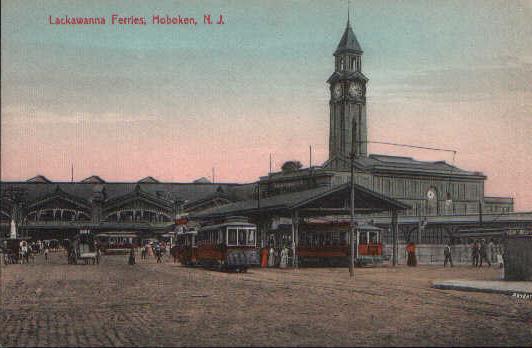 |
 The Hoboken Ferry
The Hoboken Ferry
By Leonard A. Luizzi
The story of Hoboken as a modern-day city cannot be told without reference to the Stevens family. Col. John Stevens purchased "Bayard's Farm" in 1784, over 200 years ago. Col. Stevens was a gifted engineer, who was granted patents on many inventions. The inventions of interest here are the ones he came up with to solve the problem of getting people from Manhattan to Hoboken. Like a mighty oak, you must start with a seed, and the seed that grew into our city was, to a large extent, nourished by the ferry.
Many years before Stevens purchased Hoboken, a small ferry ran across the Hudson, run by a Dutchman with a rowboat. His name was William Jansen, and he rowed a boat from the southeast point of his farm to lower Manhattan Island as early as 1616. A century and a half later, the ferry franchise belonged to a man named Bogart.
Col. Stevens lived in lower Manhattan at 7 Broadway, and, some time after buying Bayard's Farm, moved his family to Hoboken. Engineer that he was, it was only a matter of time before he turned his attention to Bogart's primitive and difficult way of crossing. Stevens started by buying out the franchise. It cost him $6,250, but it also came with a nice piece of land that he annexed onto his own estate. At the time, ferries either crossed as sailboats or as rowboats, and both were at the mercy of winds and tides. What Stevens did was to work out how to power a boat using the recently-invented steam engine. Kids in school learn that Robert Fulton invented the steamboat, but the fact is that Stevens did it first. It took him a lot of years of trial-and-error, but he finally launched the Juliana on October 11, 1811, as the first practical steam ferry in the world, taking passengers between Hoboken and Vesey Street in New York City. This was a full three years before Fulton's Clermont tested the waters of the Hudson.
But a problem arose. Stevens had a ferry boat, but he wasn't allowed to run it. The State of New York has complete jurisdiction over its own waterways, and, in those days, the Hudson River was considered to be part of New York. When it came time to decide who could run the lucrative ferry route, the award went to Robert Fulton and his partner, Robert Livingston. Fulton and Livingston had complete control over who got to use steam engines on the Hudson, and they shut Stevens out. As an aside, it should be noted that Livingston was Stevens' brother-in-law. The steamboat privilege was granted to the Powles Hook Ferry Company, who were the only ones allowed access to New Jersey ports from Paulus Hook up to Weehawken. Stevens tried leasing his ferry to John, Robert and Samuel Swartwout in 1817 for a period of ten years. But after only four years, the brothers' venture failed, and Stevens took back control of the ferries in 1821.
Finally, in 1822, Col. Stevens organized the "Hoboken Steamboat Ferry Company," thus defying the New York State Legislature. His steam ferry Hoboken began a regular run from Hoboken to Vesey Street in Manhattan. This run would continue for the next 145 years. On the Hoboken side, a wooden "ferry house" and train station was built.
The Stevens family heirs sold the Hoboken Ferry to the Lackawanna Railroad in 1903. The "ferry house" burned down on August 7, 1905, and was replaced by the present terminal building in 1907. This one is actually the fourth terminal on the same site. Its architecture is Beaux-Arts, and it is on the National Register of Historic Places.
The steam ferry service started by Col. Stevens in 1822 ended on Wednesday, November 22, 1967. But this proved to be a temporary stop. In 1989, a company named NY Waterways began the Hoboken ferry anew, and, just like our city, the ferry was reborn.

|
|
 |